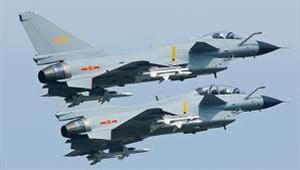Chinese J-10
The Chinese J-10 fighter is one of China’s most ambitious fighter programmes – and one of the most controversial too. The story of this aircraft began when the No. 611 Research Institute in Chengdu launched Project 8810 – a fourth-generation fighter intended as a successor to the J-7 and, to a certain extent, the Q-5. The need for such an aircraft was becoming increasingly acute, considering that the previous Chinese tactical fighter projects (the J-9, J-11 and J-13) had come to nothing. Initially the J-10 was to be an air superiority fighter designed to oppose the then-latest Soviet fighters – the Mikoyan MiG-29 (NATO reporting name Fulcrum) and Sukhoi Su-27 (NATO reporting name Flanker). This should come as no surprise, as Sino-Soviet relations were still somewhat strained at the time.
China did its best to keep the Chengdu J-10 secret, and until recently very little was made public about this programme, giving rise to conflictinq reports. Thus, the programme launch date has been reported as 1984, 1986 or even October 1988.
The J-9 had utilised a canard delta layout with a single afterburning turbofan, and the designers at Chengdu chose to retain this layout for the J-10. An early version of the project featured Mirage-style semicircular lateral intakes with half-cone centre- bodies, but these were soon rejected.
 Whilst the fighter’s general arrangement was being defined, help came from Israel. In 1980-87 the latter country had developed its own fourth-generation fighter – the lAI Lavi (Young Lion). This aircraft, which was based on F-16 technology, first flew in 1986 but eventually the programme was cancelled for various reasons. The Lavi utilised a canard delta layout, featuring a blended wing/body (BWB) design with a single chin air intake. When the first pictures of the Chengdu J-10 became available in the mid-1990s, showing a strong similarity to the Lavi, Israel strongly denied that technology transfer had taken place. So did China at first (albeit probably for different reasons); yet the two nations had co-operated in defence matters since the early 1980s, and the Lavi clearly had an influence on shaping the outlook of the Chinese fighter. Not until 1995 was the transfer of the Lavi’s design documents to China officially admitted.
Whilst the fighter’s general arrangement was being defined, help came from Israel. In 1980-87 the latter country had developed its own fourth-generation fighter – the lAI Lavi (Young Lion). This aircraft, which was based on F-16 technology, first flew in 1986 but eventually the programme was cancelled for various reasons. The Lavi utilised a canard delta layout, featuring a blended wing/body (BWB) design with a single chin air intake. When the first pictures of the Chengdu J-10 became available in the mid-1990s, showing a strong similarity to the Lavi, Israel strongly denied that technology transfer had taken place. So did China at first (albeit probably for different reasons); yet the two nations had co-operated in defence matters since the early 1980s, and the Lavi clearly had an influence on shaping the outlook of the Chinese fighter. Not until 1995 was the transfer of the Lavi’s design documents to China officially admitted.
True enough, the Chinese J-10 was no carbon copy of the Lavi after all. The Chinese aircraft was larger; its wing plan- form was different, with a kinked leading edge and no trailing-edge sweep, and the canards were set higher. Unlike the Israeli fighter, which had a fixed-area air intake of quasi-elliptical cross-section, the J-10 featured a two-dimensional variable air intake. Also, the two aircraft were developed to meet different requirements. The Lavi was optimised for strike missions, with air superiority as a secondary role; with the J-10 it was vice versa.
